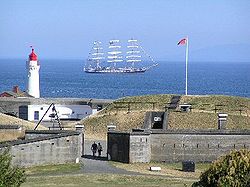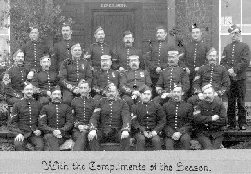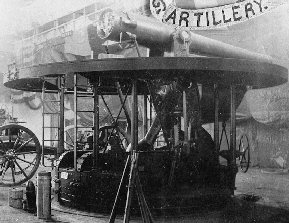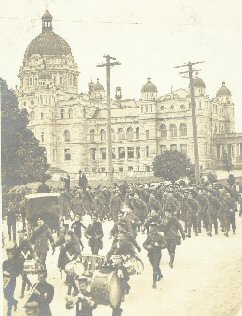
Fort Rodd Hill National Historic Site
Encyclopedia

Artillery
Originally applied to any group of infantry primarily armed with projectile weapons, artillery has over time become limited in meaning to refer only to those engines of war that operate by projection of munitions far beyond the range of effect of personal weapons...
fort on the Colwood, British Columbia
Colwood, British Columbia
Colwood is a city located on Vancouver Island to the southwest of Victoria, capital of British Columbia. Colwood was incorporated in 1985 and has a population of approximately 15,000 people. Colwood lies within the boundaries of the Victoria Census Metropolitan area or Capital Regional District,...
side of Esquimalt Harbour
Esquimalt Harbour
Esquimalt Harbour is a sheltered body of water in Greater Victoria, British Columbia, Canada. It is connected to the Strait of Juan de Fuca by a narrow channel known as Royal Roads. Its entrance is marked by Fisgard Lighthouse....
, (Greater Victoria/Victoria BC Metropolitan Area). The site is adjacent to Fisgard Lighthouse National Historic Site
Fisgard Lighthouse National Historic Site
Fisgard Lighthouse National Historic Site in Colwood, British Columbia, on Fisgard Island at the mouth of Esquimalt Harbour, is the site of Fisgard Lighthouse, the first lighthouse on the west coast of Canada.-History:...
, the first lighthouse
Lighthouse
A lighthouse is a tower, building, or other type of structure designed to emit light from a system of lamps and lenses or, in older times, from a fire, and used as an aid to navigation for maritime pilots at sea or on inland waterways....
on the west coast of Canada. Both the fort and lighthouse are managed and presented to the public by Parks Canada
Parks Canada
Parks Canada , also known as the Parks Canada Agency , is an agency of the Government of Canada mandated to protect and present nationally significant natural and cultural heritage, and foster public understanding, appreciation, and enjoyment in ways that ensure their ecological and commemorative...
, and are open every day (except Christmas Day).
History
Rodd Hill was named for John Rashleigh Rodd, 1st Lieutenant on the (Capt. John A. Dunze. Rodd was later promoted to rear admiral in 1877; vice admiral in 1884, and admiral in 1888.1850-1878
Britain's Royal NavyRoyal Navy
The Royal Navy is the naval warfare service branch of the British Armed Forces. Founded in the 16th century, it is the oldest service branch and is known as the Senior Service...
began using Esquimalt harbor in the 1840s, at first merely for anchorage, watering and for lumber; but the establishment of three hospital huts during the Crimean War
Crimean War
The Crimean War was a conflict fought between the Russian Empire and an alliance of the French Empire, the British Empire, the Ottoman Empire, and the Kingdom of Sardinia. The war was part of a long-running contest between the major European powers for influence over territories of the declining...
of 1854-56 marked the start of what is still an active naval base.
In 1862, the Royal Navy's Pacific Squadron was relocated to Esquimalt harbour from Valparaíso, Chile (where it had utilised floating storeships rather than built facilities ashore). This increased presence, eventually including storehouses and workshops ashore, would require some form of coastal defence to deter naval attack by any potential enemy. This need was reinforced by the influx of American gold miners during the Fraser River
Fraser River
The Fraser River is the longest river within British Columbia, Canada, rising at Fraser Pass near Mount Robson in the Rocky Mountains and flowing for , into the Strait of Georgia at the city of Vancouver. It is the tenth longest river in Canada...
Gold Rush
Gold rush
A gold rush is a period of feverish migration of workers to an area that has had a dramatic discovery of gold. Major gold rushes took place in the 19th century in Australia, Brazil, Canada, South Africa, and the United States, while smaller gold rushes took place elsewhere.In the 19th and early...
of 1858, and by the armed standoff of U.S. and British forces during the San Juan Islands
San Juan Islands
The San Juan Islands are an archipelago in the northwest corner of the contiguous United States between the US mainland and Vancouver Island, British Columbia, Canada. The San Juan Islands are part of the U.S...
Pig War
Pig War
The Pig War was a confrontation in 1859 between the United States and the British Empire over the boundary between the US and British North America. The territory in dispute was the San Juan Islands, which lie between Vancouver Island and the North American mainland...
of 1859 and continuing tensions associated with that dispute until its resolution in 1871.
It was not until after the Colony of Vancouver Island
Vancouver Island
Vancouver Island is a large island in British Columbia, Canada. It is one of several North American locations named after George Vancouver, the British Royal Navy officer who explored the Pacific Northwest coast of North America between 1791 and 1794...
had joined the mainland of British Columbia
British Columbia
British Columbia is the westernmost of Canada's provinces and is known for its natural beauty, as reflected in its Latin motto, Splendor sine occasu . Its name was chosen by Queen Victoria in 1858...
in 1866, and then Canada in 1870, that the first fixed coastal defences were emplaced to protect the naval base. During the Great Eastern Crisis in 1877-78, increased tension between Britain and Russia over the latter's declaration of war on Turkey focused attention on the lack of defences for Britain's only naval station on the western seaboards of both North and South America. Volunteers for artillery training were mustered in Victoria on the 18th of May, while Lt-Col De La Chevois Irwin, Inspector-General of Artillery at Kingston, Ontario, was sent (by train, across the USA) to organize the defences.
Five batteries of guns (mainly 64-pr naval rifled muzzle loader) were constructed quickly, using earthen ramparts shored with timber. The largest guns of these defences were three 7-inch RML guns at Macaulay Point (covering the entrance of both Victoria and Esquimalt harbours), and one 8-inch RML on Brothers Island (at the mouth of Esquimalt harbor).
The Commander-in-Chief of the Pacific Squadron
Pacific Station
The Pacific Station, often referred to as the Pacific Squadron, was one of the geographical divisions into which the Royal Navy divided its worldwide responsibilities...
, Admiral de Horsey
Algernon Frederick Rous de Horsey
Admiral Sir Algernon Frederick Rous de Horsey KCB was a Royal Navy officer who served in the nineteenth century.-Early life:...
, inspected the new batteries and declared them inadequate; the local artillery militia could only muster enough gunners to serve half the guns and as local citizens, it was felt that they might be inclined to give preference to guns defending Victoria rather than the naval base. De Horsey recommended that a permanent garrison
Garrison
Garrison is the collective term for a body of troops stationed in a particular location, originally to guard it, but now often simply using it as a home base....
of 100 Royal Marine Artillery, modern guns, and a submarine minefield be established as permanent defences.
1878-1906
The Canadian and British governments did not reach a defence agreement on the matter until 1893; during this time, the old guns and emplacements were still Victoria and Esquimalt's only fixed defences against attack. The 1893 agreement boiled down to this:The British government would supply:
- guns, equipment, stores, and submarine mining buildings, to a total of £53,080;
- half the estimated cost of the defence works (£30,000);
- half the cost of annual maintenance (£500);
- and a garrison of 75 Royal Marine Artillerymen.
The Dominion of Canada would provide:
- all the land and buildings (save the submarine mining establishment);
- £10,000 towards the maintenance of the Royal Marine Artillery garrison; half the estimated cost of the defences (£30,000);
- half the cost of annual maintenance (£500);
- and maintain and expand the local militia.
The Royal Marine Artillery garrison, composed of specialists with two years' training, arrived in 1894; they were joined by officers and men of the Royal Engineers, to oversee construction of the permanent defences. The original plan called for Chinese labour to be used in construction, but local newspapers lobbied against this, and more expensive European (i.e., "white") day labourers were employed.

Disappearing gun
A disappearing gun is a type of heavy artillery for which the gun carriage enabled the gun to rotate backwards and down into a pit protected by a wall or a bunker after it was fired...
s (Mk VI barrels on a Mk IV mounting). Because of limitations of space in Rodd Hill, two of these guns were mounted with a common magazine in "Lower Battery", while the third required a separate battery (along with an underground magazine, loopholed wall, water supply, guardhouse
Guardhouse
A guardhouse is a building used to house personnel and security equipment...
, etc.) on another, higher hill some 200 meters away, named, logically, "Upper Battery."
These guns were sited in concrete emplacements ten feet thick, which were in turn protected by the rock massif of the hillside into which they were sunk. The barrels were normally kept down in the loading position, within the protection of the concrete emplacement (which also had an overhead metal shield). Using a central Observation Post and remote electric dial system to pass target information, the guns would be loaded and aimed while in the "down" position. Only when actually about to fire, would the large hydro-pneumatic system raise the 5-tonne barrel up over the parapet.
The strength of the system was that the barrel was exposed to the enemy for a minimal amount of time, and with naval guns of the time firing on a flat trajectory, it was virtually impossible for an enemy ship to drop a shell on the emplacement, with its sloping rock glacis
Glacis
A glacis in military engineering is an artificial slope of earth used in late European fortresses so constructed as to keep any potential assailant under the fire of the defenders until the last possible moment...
in front. Disadvantages of the system included a slow rate of fire (perhaps one shot every two minutes), and a propensity for the complicated hydro-pneumatic system to leak.

In addition to these medium guns (intended to fend off an attack by up to six enemy light cruisers), smaller quick-firing guns were sited, in order to deal with the potential threat of fast, unarmoured torpedo boat
Torpedo boat
A torpedo boat is a relatively small and fast naval vessel designed to carry torpedoes into battle. The first designs rammed enemy ships with explosive spar torpedoes, and later designs launched self-propelled Whitehead torpedoes. They were created to counter battleships and other large, slow and...
s. At Fort Rodd, a separate emplacement, called Belmont Battery was constructed to house two Quick-Firing 12-pr guns, which were assisted by two sets of "Defence Electric Lights" (searchlights), which were powered by diesel engine
Diesel engine
A diesel engine is an internal combustion engine that uses the heat of compression to initiate ignition to burn the fuel, which is injected into the combustion chamber...
s and generators concealed in an engine room built into the landward side of a hill.
For heavy, "counter-bombardment" defence, a battery of 9.2-inch guns was built at Signal Hill, on the east side of Esquimalt harbour; in the event, these guns did not become active until 1912, and even then were rarely fired, as the concussion caused much damage to windows in Esquimalt village, directly below the battery.
The Royal Marine Artillery garrison was supplanted in 1899 by a larger garrison of Royal Garrison Artillery
Royal Garrison Artillery
The Royal Garrison Artillery was an arm of the Royal Artillery that was originally tasked with manning the guns of the British Empire's forts and fortresses, including coastal artillery batteries, the heavy gun batteries attached to each infantry division, and the guns of the siege...
personnel, along with a detachments of Royal Engineers
Royal Engineers
The Corps of Royal Engineers, usually just called the Royal Engineers , and commonly known as the Sappers, is one of the corps of the British Army....
, including one specially trained in submarine mining. The local Canadian artillery militia continued to receive instruction and practice in gunnery, and became very proficient, winning several national competitions. Annual training schemes brought both Imperial and Colonial troops into sham battles and exercises, including a full-scale night assault on Fort Rodd Hill and Esquimalt naval base in 1902.


